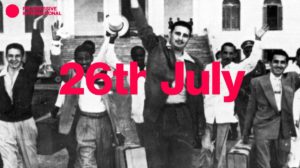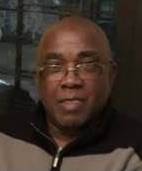|
Getting your Trinity Audio player ready...
|
Reading Time 3 mins
July 28, 2021
As if taking cues from the Trump era, the Biden- Harris administration has renewed US restrictions on Cuba when humanity should be doing the opposite – extending international solidarity in this time of a global Covid pandemic. This moment, however, provides a teachable opportunity in which we can reflect on the significance of the Cuban Revolution to humanity, especially to the people of Latin America and the Caribbean.
Harris administration has renewed US restrictions on Cuba when humanity should be doing the opposite – extending international solidarity in this time of a global Covid pandemic. This moment, however, provides a teachable opportunity in which we can reflect on the significance of the Cuban Revolution to humanity, especially to the people of Latin America and the Caribbean.
Monday, July 26, 2021, was the 68th anniversary of the glorious Cuban 1953 movement that sounded the death knell against the corrupt dictatorship of Fulgencio Batista, the tyrannical US-backed leader of Cuba. But, unfortunately, the intent of U.S. imperialistic policies and ambitions has always been to control the social and political economy of the Cuban people.
The attack against the corrupt dictatorship began on July 26 by a small group of dedicated Cuban revolutionaries led by a young leader named Fidel Castro, an activist student at the University of Havana.
The focus of the revolutionaries’ attacks was on the Moncada Barracks, a citadel of US neo-colonialism. The Barracks, located in Santiago, served as a nerve center of oppression that Batista and his goons utilized to terrorize and punish the Cuban people.
Was the attack on the Moncado Barracks successful?
The purpose of the attack on the Barracks was to start a revolution against the corrupt dictatorship of Batista. Unfortunately, however, Fidel Castro and his comrades failed. The Batista regime captured Castro and ‘sentenced’ him to jail for fifteen years. And, the illegal government even murdered some revolutionary comrades.
Although Fidel and his compatriots failed on their first attempt, the attack on the Moncada Barracks was a strategic victory as it showed that Batista’s authoritarian rule was fragile. However, Fidel’s credibility with the masses of Cuban people was very high. As a result, supporters organized a mass campaign that led to Fidel’s amnesty after two years of imprisonment.
After his arrest Fidel Castro delivered a historic four-hour History Will Absolve Me speech defending the July 26th Movement. The substance of the speech was to be published as a manifesto of the Movement that eventually successfully overthrew the Batista government, taking power in 1959
 The July 26th, 1953 movement was organized in Mexico in the 1950s by 82 exiled revolutionaries, including Fidel Castro, his brother Raul Castro, Camilo Cienfuegos, Huber Matos, and Ernesto Che Guevara. Their second attempt and task were to form a disciplined guerrilla force to overthrow the oppressive government of Fulgencio Batista. They were victorious in this second attack!
The July 26th, 1953 movement was organized in Mexico in the 1950s by 82 exiled revolutionaries, including Fidel Castro, his brother Raul Castro, Camilo Cienfuegos, Huber Matos, and Ernesto Che Guevara. Their second attempt and task were to form a disciplined guerrilla force to overthrow the oppressive government of Fulgencio Batista. They were victorious in this second attack!
The movement later joined with other organized bodies to form the United Party of the Cuban Socialist Revolution, which became the Communist Party of Cuba in 1965.
What were some of the historical, social, and economic crises that led to the development?
Batista, in 1933 created a group of enlisted sergeants in the Cuban army which was used as a springboard to grab state power. It was called the “Sergeants’ Coup” of 1933. He ruled Cuba from behind the scenes for some time and eventually made himself President in 1940.
In his early administration, Batista’s policies were relatively progressive and pro-worker and thus was supported by the Cuban Communist party and labor unions.
Batista relinquished power in 1944 and went to live in the U.S. for a while. On his return to Cuba, he ran for President again in 1952. When he realized he would lose the election, he organized an armed Coup d’état. Batista became extraordinarily corrupt and violent. He worked for and catered to the interest of wealthy Cubans and the Meyer Lansky wing of the U.S. mobsters who ran the Casinos in Havana.
The Batista dictatorship killed thousands of political opponents, and the poor Cuban masses were left mercilessly to the wicked devices of the tyranny of Batista and the Mayer Lansky mobsters. They ran the casinos and the prostitution brothels. Nevertheless, the July 26, 1953 movement in Cuba lit the spark to create a significant progressive change in Cuba and across the world in Africa, Latin America, and the Caribbean.
 We must preserve the glorious history of these brave Cuban men and women by continuing the just fight against the vampire of colonialism, neocolonialism, and U.S. imperialism. We must continue our struggle in our respective countries boldly and in the traditions of our heroic fighters like the comrades of the July 26 movements. We also should be motivated by the freedom fighters in our respective countries and across the world.
We must preserve the glorious history of these brave Cuban men and women by continuing the just fight against the vampire of colonialism, neocolonialism, and U.S. imperialism. We must continue our struggle in our respective countries boldly and in the traditions of our heroic fighters like the comrades of the July 26 movements. We also should be motivated by the freedom fighters in our respective countries and across the world.
Many of the Maroons like Paul Bogle and Nanny of Jamaica; Simon Bolivar and Hugo Chavez of Venezuela; Winnie Mandela and Chris Hani of South Africa; Maurice Bishop of Grenada; and Fidel Castro and Jose Marti of Cuba, continue to inspire progressives in the quest for freedom and national liberation. So let’s not fold our hands and efforts in complacency.
Let’s raise our banner high and honor our comrades who have paid the ultimate price for all the struggling people worldwide for justice, peace, and equality.
Victory will be ours! Our struggles continue.
I dedicate this article to my comrade and friend, Richard Hoyen, an outstanding Jamaican internationalist and a great humanitarian. Richard joined the ancestors in April 2020. RIP comrade!
 Winston Simmond is a retired NYC Public School teacher and Assistant Principal.
Winston Simmond is a retired NYC Public School teacher and Assistant Principal.
